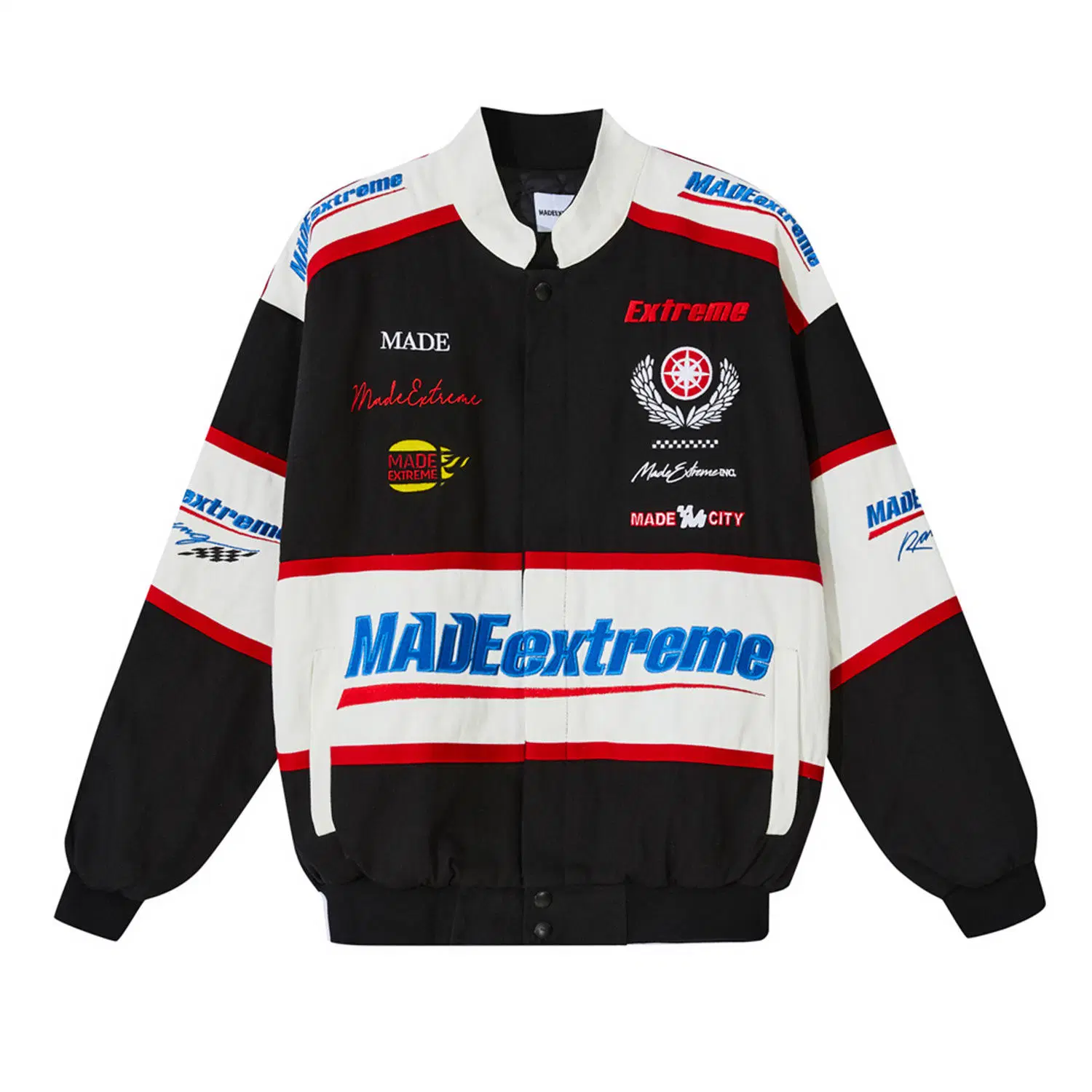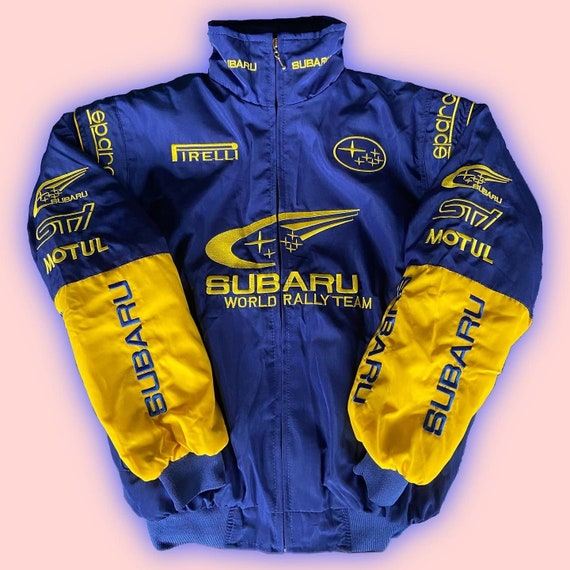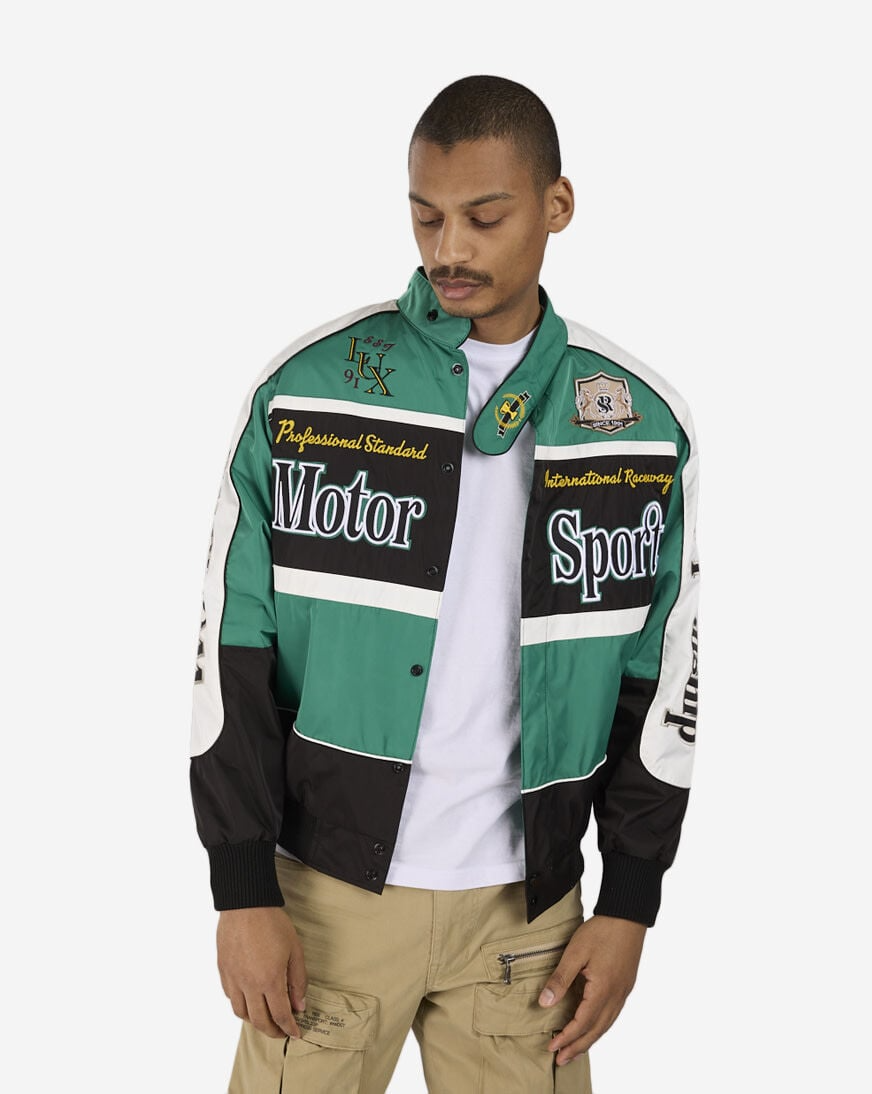Introduction to Racing Jackets
Racing jackets are more than just stylish pieces of clothing. They are essential gear for anyone involved in motorsports. These jackets provide protection, enhance performance, and add a touch of style. They cater to different types of racing, from motorcycles to car racing. Today’s racing jackets blend advanced materials and innovative designs to meet the demands of modern racers. They offer comfort, safety, and aesthetics, all in one package.

Racing jackets come in various designs and styles. Some focus on providing maximum protection. Others offer a balance between safety and comfort. The wide range of options ensures that there is something for every racer. These jackets have specific features tailored to different racing needs. For example, motorcycle racing jackets usually have armor inserts. Car racing jackets, on the other hand, often focus on fire resistance.
The evolution of racing jackets has been significant. Initially, they were simple leather outfits. Nowadays, materials like Kevlar, Gore-Tex, and various composites make them more effective. The combination of technology and design ensures that modern racing jackets offer unparalleled protection and performance. This article explores the world of racing jackets. We’ll delve into their history, different types, materials used, and the importance of safety features. Our aim is to provide a comprehensive understanding of why a racing jacket is a must-have for any serious racer.
The Evolution of Racing Jackets
A Historical Perspective
Racing jackets have a rich history. They first appeared in the early days of motorsports. Back then, they were primarily made from leather. Leather was durable and offered a fair amount of protection. Early racers valued leather for its ability to withstand abrasions. These simple designs were functional but lacked the advanced features we see today.
As motorsports evolved, so did the jackets. The need for better protection and comfort led to innovations. Manufacturers started experimenting with different materials. Textile jackets became popular, offering more flexibility and ventilation. The 1980s and 1990s saw significant advancements in racing jacket technology. Brands began incorporating advanced materials like Kevlar and Gore-Tex. These innovations improved both safety and comfort.
The introduction of armor inserts was another milestone. These inserts provided additional protection for vulnerable areas like elbows, shoulders, and back. Today’s racing jackets offer a blend of tradition and innovation. They maintain the durability of leather but incorporate modern materials for enhanced performance. The result is a jacket that offers comprehensive protection without compromising comfort.
Modern Innovations
Modern racing jackets are a marvel of engineering and design. They use advanced materials to offer superior protection. Kevlar, a high-strength synthetic fiber, is a common component. It provides excellent resistance to abrasions and impacts. Another popular material is Gore-Tex. This fabric is waterproof yet breathable, making it ideal for various weather conditions. These materials ensure that the jacket remains effective in different racing environments.
The design of modern racing jackets also focuses on ergonomics. They are tailored to fit the rider’s body, allowing for maximum flexibility and comfort. Adjustable straps and zippers help customize the fit. This ensures that the jacket stays in place during high-speed maneuvers. Ventilation is another crucial aspect. Modern jackets feature perforated panels and air vents. These elements help regulate temperature, keeping the rider cool and comfortable.
Safety features have also seen significant advancements. Today’s racing jackets often come with built-in armor inserts. These provide additional protection for critical areas. Some high-end models even feature airbag systems. These inflate upon impact, providing an extra layer of protection. Reflective elements are another important feature. They enhance visibility, especially in low-light conditions. These innovations make modern racing jackets a perfect blend of safety, comfort, and style.
Types of Racing Jackets
Motorcycle Racing Jackets
Motorcycle racing jackets are designed for riders who need maximum protection. These jackets focus on shielding the rider from abrasions and impacts. They often feature armor inserts in key areas like elbows, shoulders, and back. Some models even include chest protectors. The materials used are usually a combination of leather and advanced textiles like Kevlar.
The design of motorcycle racing jackets emphasizes aerodynamics. A snug fit reduces wind resistance, enhancing the rider’s performance. Adjustable straps ensure that the jacket stays in place at high speeds. Ventilation is another critical aspect. Vents and perforated panels help regulate body temperature, keeping the rider cool during intense rides.
Motorcycle racing jackets also incorporate safety features like reflective elements. These enhance visibility, making the rider more noticeable to other road users. Some jackets come with integrated airbag systems. These inflate upon impact, providing additional protection. These features make motorcycle racing jackets indispensable for serious riders.
Car Racing Jackets
Car racing jackets focus on fire resistance and comfort. They often use materials like Nomex, a fire-resistant fabric. This material provides crucial protection in the event of a fire. The design of these jackets is also more relaxed compared to motorcycle racing jackets. This allows for better freedom of movement within the car.
Car racing jackets also include other safety features. These often involve flame-retardant stitching and zippers. Some high-end models feature built-in cooling systems. These use tubes and fans to regulate the driver’s body temperature. Reflective elements are less common but can still be found on some jackets. These features make car racing jackets a vital part of any driver’s gear.
Car racing jackets also pay attention to comfort. They include features like padded collars and adjustable cuffs. These elements enhance the overall comfort, making long races more bearable. The combination of fire resistance, comfort, and additional safety features makes these jackets essential for car racers.
Multi-Purpose Racing Jackets
Multi-purpose racing jackets offer versatility. They cater to different types of racing and other high-speed activities. These jackets often combine features from both motorcycle and car racing jackets. They focus on providing a balance between protection, comfort, and flexibility.
The materials used in multi-purpose racing jackets are diverse. They often feature a blend of leather, Kevlar, and Gore-Tex. This combination provides excellent protection against abrasions and impacts. Ventilation is another critical feature. These jackets include perforated panels and air vents. This helps regulate body temperature, keeping the rider comfortable.
Safety features are comprehensive. Multi-purpose racing jackets often come with armor inserts and reflective elements. Some models even include airbag systems. These features make them suitable for a range of activities, from motorcycle racing to high-speed car driving. This versatility makes them a popular choice among racers who participate in multiple disciplines.
Materials Used in Racing Jackets
Leather
Leather is one of the most traditional materials used in racing jackets. It is known for its durability and resistance to abrasions. Leather jackets provide excellent protection in the event of a slide or fall. They are particularly popular among motorcycle racers. The material’s natural properties offer a combination of strength and flexibility.
The durability of leather also ensures longevity. A well-maintained leather jacket can last for many years. This makes it a cost-effective investment over time. The material also offers a classic look, appealing to those who appreciate traditional aesthetics. However, leather can be heavy and less breathable compared to modern textiles.
Manufacturers often treat leather to enhance its properties. Treatments can improve water resistance and flexibility. This ensures that the jacket remains effective in different weather conditions. Despite the emergence of new materials, leather remains a popular choice for racing jackets.
Kevlar
Kevlar is a high-strength synthetic fiber known for its durability and resistance to impacts. This material is commonly used in modern racing jackets. Kevlar offers excellent protection against abrasions, making it ideal for high-speed activities. It is lightweight yet incredibly strong, providing superior protection without adding extra weight.
Kevlar’s durability extends to its resistance to wear and tear. This makes it a reliable choice for long-term use. The material also offers some degree of flexibility, ensuring that the jacket remains comfortable. Manufacturers often combine Kevlar with other materials like leather or Gore-Tex. This combination provides a balance between protection and comfort.
The material’s properties also include heat resistance. This makes Kevlar suitable for car racing jackets, where fire resistance is crucial. The combination of strength, flexibility, and heat resistance makes Kevlar a versatile material for racing jackets.
Gore-Tex
Gore-Tex is a popular material known for its waterproof and breathable properties. This fabric is commonly used in racing jackets to provide comfort in various weather conditions. Gore-Tex allows moisture to escape while preventing water from entering. This keeps the rider dry and comfortable.
The breathability of Gore-Tex is a significant advantage. It helps regulate body temperature, especially during intense activities. The material is also lightweight, adding minimal weight to the jacket. This enhances the overall comfort and performance of the rider.
Gore-Tex is often combined with other materials like Kevlar or leather. This combination provides comprehensive protection and comfort. The material’s versatility makes it suitable for different types of racing jackets, from motorcycle to car racing.
Safety Features in Racing Jackets
Armor Inserts
Armor inserts are essential safety features in racing jackets. These inserts provide additional protection for vulnerable areas like elbows, shoulders, and back. They are often made from high-impact resistant materials like D3O or polyurethane. These materials absorb and dissipate the energy from impacts, reducing the risk of injury.
The placement of armor inserts is strategic. Manufacturers design the inserts to protect the most vulnerable areas during a fall or crash. Some jackets even allow customization, enabling riders to add or remove inserts as needed. This flexibility ensures that the jacket meets the specific safety requirements of the rider.
Armor inserts are particularly crucial in motorcycle racing jackets. The high speeds and exposure make additional protection necessary. However, they are also found in some car racing jackets. These inserts provide comprehensive protection, enhancing the overall safety of the jacket.
Reflective Elements
Reflective elements enhance visibility, making the rider more noticeable to other road users. These features are particularly important for motorcycle racing jackets. The high speeds and low-light conditions make visibility crucial. Reflective elements help ensure that the rider remains visible, enhancing safety.
Manufacturers strategically place reflective elements on the jacket. These include areas like the back, chest, and sleeves. The placement ensures maximum visibility from different angles. Some jackets even feature customizable reflective panels. This allows riders to adjust the visibility according to their specific needs.
Reflective elements are less common but still present in car racing jackets. They enhance visibility, especially in dark or low-light conditions. The combination of reflective elements and other safety features makes racing jackets comprehensive safety gear.
Airbag Systems
Airbag systems are advanced safety features found in some high-end racing jackets. These systems inflate upon impact, providing an extra layer of protection. The airbags help cushion the rider, reducing the risk of injury. This feature is commonly found in motorcycle racing jackets but is also available in some car racing models.
The airbag systems are often integrated into the jacket’s design. Sensors detect an impact, triggering the inflation of the airbags. The system is designed to deploy quickly, ensuring immediate protection. Some jackets even allow for reusable airbag systems. This means that the airbags can be reset and used multiple times.
The inclusion of airbag systems significantly enhances the safety of the jacket. They provide comprehensive protection, especially in high-speed crashes. This advanced feature makes racing jackets indispensable for serious racers.
Choosing the Right Racing Jacket
Understanding Your Needs
Choosing the right racing jacket involves understanding your specific needs. Different types of racing require different features. Motorcycle racing jackets focus on impact protection and aerodynamics. Car racing jackets prioritize fire resistance and comfort. Identifying your needs helps narrow down the options.
Consider the material and construction of the jacket. Leather offers durability and a classic look. Kevlar provides superior abrasion resistance. Gore-Tex offers waterproof and breathable properties. Understanding the benefits of each material helps in making an informed decision.
Safety features are another critical aspect. Look for jackets with armor inserts and reflective elements. Airbag systems provide advanced protection. Ensure that the jacket meets safety standards and certifications. This ensures that you have reliable protection during your races.
Fit and Comfort
Fit and comfort are crucial when choosing a racing jacket. The jacket should fit snugly but not restrict movement. Adjustable straps and zippers help customize the fit. This ensures that the jacket stays in place during high-speed activities.
Consider the jacket’s ergonomics and design. Look for features like padded collars and adjustable cuffs. Ventilation is also important. Perforated panels and air vents help regulate body temperature. This ensures that you remain comfortable during intense rides.
Comfort extends to the jacket’s weight. Lightweight materials like Kevlar and Gore-Tex add minimal weight. This enhances the overall comfort and performance. Ensure that the jacket offers a balance between protection and comfort.
Durability and Maintenance
Durability is a critical factor when choosing a racing jacket. High-quality materials like leather, Kevlar, and Gore-Tex offer excellent durability. Heat treatment and advanced engineering techniques enhance the jacket’s longevity. Look for jackets that offer a combination of strength and flexibility.
Maintenance is another important aspect. Some materials require specific care. Leather jackets may need regular conditioning to maintain their properties. Gore-Tex and Kevlar are easier to maintain. Ensure that you follow the manufacturer’s care instructions. This helps extend the life of the jacket.
Consider the warranty and customer support. Reputable brands offer warranties on their products. This ensures that you have a reliable jacket. Good customer support helps in addressing any issues or concerns. This enhances your overall experience and satisfaction.
Conclusion
Racing jackets are essential gear for anyone involved in motorsports. They offer a blend of protection, comfort, and style. The evolution of racing jackets has seen significant advancements. Modern jackets use advanced materials like Kevlar and Gore-Tex. These materials offer superior protection and performance.
The types of racing jackets cater to different needs. Motorcycle racing jackets focus on impact protection. Car racing jackets prioritize fire resistance. Multi-purpose jackets offer versatility. Understanding your specific needs helps in choosing the right jacket.
Safety features are crucial. Armor inserts, reflective elements, and airbag systems enhance protection. The fit and comfort of the jacket are also important. Ensure that the jacket offers a balance between protection and comfort. Durability and maintenance are critical factors. High-quality materials and proper care extend the life of the jacket.
In conclusion, a racing jacket is a must-have for any serious racer. It provides essential protection while enhancing comfort and style. Investing in a high-quality racing jacket ensures that you are well-prepared for any racing conditions. Choose a jacket that meets your specific needs and enjoy the exhilaration of racing with complete peace of mind.




